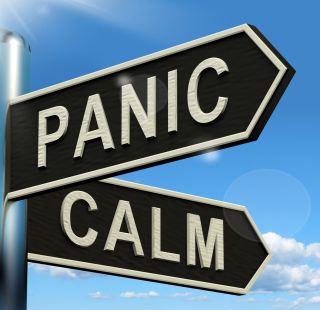Anxiety
Is Digital Overload Increasing Your Anxiety?
Why creating your own calm is necessary for mental health.
Posted August 20, 2024 Reviewed by Lybi Ma
Key points
- Psychophysiology shows us we are consistently transforming in accordance with our repeated experiences.
- Digital overload is unceasingly activating our fear response, preventing times of necessary emotional calm.
- Creating our own calm is essential to counteract digital overload and balance our emotional and mental health.
On my morning run, I saw a woman with a shirt that said, "Create your own calm." I was struck by how simple the statement was and yet how essential the concept is to our mental and emotional health.

Look at stress, anxiety, and our current culture through the lens of psychophysiology, or how our mind and body work together. We can see why these disorders are at an all-time high and why we have a greater responsibility than ever to be intentional about counteracting them. Although it may sound dramatic, we are now responsible for creating our emotional homeostasis more than most times in human history. If we don't, our mental health will suffer.
Good or bad, you are constantly transforming
Our mental and emotional health is in constant metamorphosis or reconstruction. They mold from every momentary experience and create a greater capacity to live in those states. You transform every moment of every day. You are constantly and consistently creating capacities to live full-time from the emotional states you experience most often.
Every momentary experience you have carries a physiological imprint; your thoughts and emotions register throughout your brain, your biochemistry, and your heart coherence patterns. Further, your mind-body complex is a system of adaptation. It not only reflects your moment-to-moment emotional experience but begins to adapt accordingly.
We know that if you exercise or eat right, your body changes. By practicing a math problem or riding a bike, you get better at those things. Your systems adapt to how you train them, and your emotional systems adapt as well. You are training your emotional system (and overall mental health) with every momentary experience.
Understanding your two drives

Also, you have two primary drives that govern your emotional health. One is your fear response drive, and the other is your calm and connection drive. They are two completely different physiological states. We need both drives to survive as a species, but we can't be in both at the same time (one or the other is always dominant). The one you are in most often is the one that begins to dominate your emotional and mental health.
When you are in your fear response drive too often or too long, you experience anxiety, nervousness, worry, an inability to concentrate, narrowed thoughts, powerlessness, hopelessness, stress, anger, depression, and more. When you are rooted in your calm and connection drive, among other things, you experience optimism, resilience, creativity, an enhanced ability to cope, greater problem-solving skills, less loneliness, and you more readily see opportunities, possibilities, and solutions.
Although your fear response drive is necessary for survival, residing in it too long or too often can be detrimental to your mental and emotional health. Conversely, creating moments where your calm and connection drive is dominant creates a greater capacity to live from that drive. But, unless we are intentional, our current culture is often at odds with cultivating calm and connection.
Why are anxiety and stress disorders at an all-time high? And what does our current culture have to do with it? A look at the intersection of anthropology and psychophysiology can shed some light.
Our fear response drive is deeply wired in our mind-body complex as a means of survival. This drive has been necessary throughout history to mobilize us and keep us safe in times of danger—or from whatever we perceive to be dangerous. When your fear response system is activated, it sends an all-out alert throughout mind and body that floods you with stress hormones and activates your fear neural networks; it is a whole-body, all-consuming response to stress and anxiety.
Your fear response on overdrive
Our systems react the same now as they have throughout history; however, what we perceive to be threatening has drastically changed. And remember, the more your system is in any emotional state, the better it gets at living from that state — healthy or not. In ancient times, our village may have been threatened by a Saber-toothed tiger, sending out an all-out alert through our mind-body complex, but after the danger had passed, our systems would calm down and return to homeostasis. There was a better balance between times of alert and times of calm. We had the necessary times of "coming back to calm" built into our daily lives.

Fast forward to our current culture. Now, our fear response systems are activated almost 24/7. Our perceptions of threat are largely due to our interactions with technology, and many of us are in digital overload 24 hours a day. Whenever we hear a ding, a vibrate, a buzz, or feel a haptic on our wrist, our fear response systems engage, and our necessary moments of calm dwindle. While each interaction alone may seem insignificant, they add up and can be detrimental to our overall mental health. Unbeknownst to us, we are training our systems to be on constant alert, and our stress and anxiety levels soar. However, intentional calming behavior can begin to re-wire and reverse this downward spiral.
Intentional calm is more important than ever for mental health
Our mind-body complex needs times of homeostasis, or a calm system, to be emotionally healthy and balance the times of alertness. Technology is here to stay and likely to dominate more and more of our lives. Given that constant influx, we must, now more than ever, be intentional about creating moments of calm. Our culture no longer provides them automatically; we must be proactive about including them in our lives constantly and consistently. As the shirt said, we must create our own calm.
How can we better incorporate moments of calm into our daily lives? Simple practices, done consistently over time, begin to significantly change the activation levels of our fear response system. The critical concept is to spend intentional and routine time in your calm and connection system. Everyone is different; find what calms you and spend time doing it. The following are just a few examples:
- Meditate — great apps are available for guidance.
- Find moments of presence with those you love or by yourself.
- Do a digital detox — an hour a day or an occasional full day.
- Spend time in nature.
- Engage in a hobby.
- Laugh.
- Soak in the good around you.
- Make a list of what works for you and engage with it daily.
*Note: This post is for re-thinking stress and anxiety in daily life. It is not meant to treat PTSD, complex PTSD, or severe anxiety disorders.

References
Fight, flight or freeze: Implications of the passive fear response for anxiety and depression. Phobia Practice and Research Journal. Hamilton, L.
Trends in anxiety among adults in the United States, 2008–2018: Rapid increases among young adults. Journal of Psychiatric Research. R.D. Goodwin, et al.
Evolutionary mismatch. Evolution, Medicine, and Public Health. M.B. Manus.
Increasing digitalization is associated with anxiety and depression: A Google Ngram analysis. Plos1. G.W. Teepe, et al.




